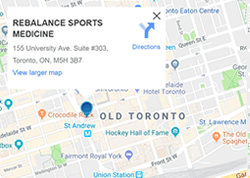What is Nerve Flossing and Why Did My Physiotherapist Give it to Me?
 Many people commonly report that when they have very tight calves or hamstrings and when they try to bend forward to touch their toes they feel a weird intense stretch in their calves. What they do not realize is the stretch they are feeling in the back of their legs is not the hamstring or gastrocnemius (calf) muscle but rather the nerves that travel down the back of the leg. It is common to hear that people try to stretch their calves or hamstrings but make limited progress. This is likely because it is the nerve that is causing the tension and nerves do not like to be stretched!
Many people commonly report that when they have very tight calves or hamstrings and when they try to bend forward to touch their toes they feel a weird intense stretch in their calves. What they do not realize is the stretch they are feeling in the back of their legs is not the hamstring or gastrocnemius (calf) muscle but rather the nerves that travel down the back of the leg. It is common to hear that people try to stretch their calves or hamstrings but make limited progress. This is likely because it is the nerve that is causing the tension and nerves do not like to be stretched!
Consider the anatomy of the biggest calf muscle, the gastrocnemius. The gastrocnemius comes from the back of the heel up the calf and attaches just above the back of the knee. When you are bending forward to touch your toes your ankle and knee are at the same angle as when you are standing up straight. This means that the gastrocnemius muscle is not being lengthened or stretched any more when you bend forward compared to when you are standing. Rather if you think about the nervous system, nerves leave from the brain, travel through the spinal column then branch into both legs and travel all the way into the soles of the feet. When you bend forward you are putting the nerves on a big stretch from head to toe. This tension is much greater than when you are simply standing. This explains why the stretch you feel in the legs is nerve not muscle and something must be done to target the nerves to make this sensation less rather than stretch the muscle.
During a physiotherapy assessment nerve tension is assessed and if the test is positive by either having pain or having a difference from one side to another then often a nerve flossing exercise is prescribed. Nerves do not like to be stretched. In fact if you stretch a nerve you can often end up with pain 2-3 hours later as nerve has a latency effect. Think of the nerve leaving in between the joints of the spine, under the piriformis muscle in the buttock, and then deep to the hamstrings and the gastrocnemius in the back of the leg. Rather than the nerve needing to be longer the nerve needs to slide between these muscles and joints. Nerve flossing gently tugs on the nerve from one end, for example the foot, then releases from that end and tugs on the nerve from the other end, for example the head. This causes the nerve to slide back and forth between the various muscle and joint interfaces. Therapists often treat by mobilizing the joint or releasing the surrounding muscles but then follow up by getting the nerves siding between these structures. Hence the term nerve ‘flossing’.
If a nerve is getting caught between stiff joints or tight muscles the nerve can get irritated. And nerve irritation can cause pain, numbness, tingling, burning and weakness. It is important to free up the nerve to remove the irritant in order for the angry nerve to settle down and for the symptoms to resolve.
Common Nerve Flossing Exercises
-
- ‘Kick Self in Head’ Sciatic Nerve Floss
- Hands behind back sitting forward with trunk and head slouched forward
- Slowly straighten one leg out in front of you as you sit up straight and look up towards the ceiling
- Then relax the leg and slowly return to your slouched forward position and repeat
- ‘Dumping the Serving Tray’ Median Nerve Floss
- Stand pretending to hold a serving tray to your side
- Keeping your wrist bent back slowly straighten your arm directly out to your side as you tilt your head towards the same time
- Slowly return to the starting position and repeat
- ‘Kick Self in Head’ Sciatic Nerve Floss
Note if these exercises are performed incorrectly or are not appropriate for you there is potential to cause nerve irritation. They are extremely helpful exercises in certain conditions but talk to a physiotherapist before trying them on your own!
Bonnie Winship, Physiotherapist
Bonnie Winship is a registered physiotherapist practicing at Rebalance Sports Medicine in downtown Toronto.



 What to Expect From Your First Physiotherapy Visit
What to Expect From Your First Physiotherapy Visit The Benefits of Fascial Stretch Therapy [Demo]
The Benefits of Fascial Stretch Therapy [Demo] How Does Physiotherapy Work?
How Does Physiotherapy Work? Best Exercises for Low Back Pain
Best Exercises for Low Back Pain